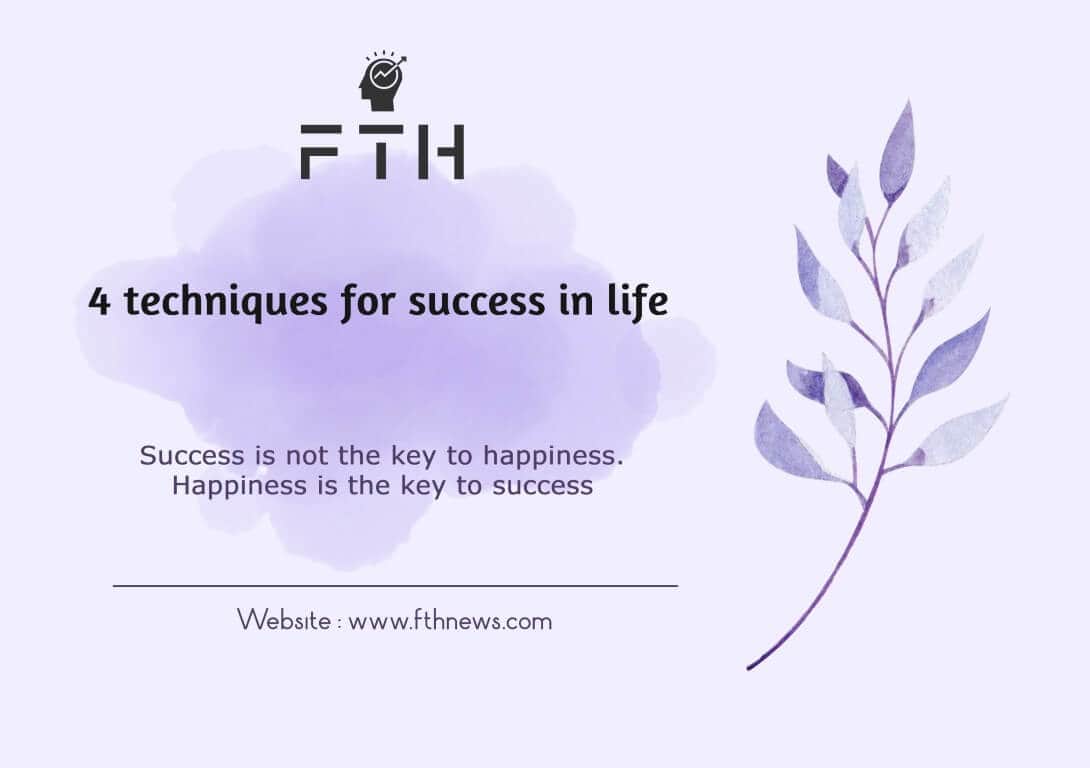
4 success techniques that will turn your life upside down
success techniques that will turn your life upside down , each has created an uproar in the world of personal and organizational development.
What are we going to learn together?
success techniques
1- We examine the Kaizen philosophy and learn about this Japanese success technique.
2- We get to know the Pareto principle and learn its solutions to increase productivity.
3- We learn how to reduce our stress in addition to increasing productivity with the “GTD” technique.
4- We use the paradox technique to make a smart and timely choice.
Albert Schweitzer, German philosopher and musician: Success is not the key to happiness. Happiness is the key to success, if you love what you do, you will succeed.
Kaizen philosophy, a technique to success
Kaizen philosophy, a technique from Japan to success
All dictionaries in the world are not printed. Sometimes experience forms a conceptual dictionary in our mind.
For example, when we hear the name “Japan”, we inevitably think of “quality”.
This is not accidental and we can even say that it was created quite intelligently and with a lot of effort by thousands of Japanese people. For the Japanese, quality is not a simple and pleasant word to parrot on the cover of their products.
The Japanese showed quality in a practical way with a special look at their production and reputation. But what made the Japanese to reach such an attitude?
The answer can be found in one of the most important philosophies of Japanese thinking, Kaizen.
Kaizen is composed of the combination of two words “Kai” meaning change and “Zen” meaning good. This Japanese philosophy has two main parts.
The first part of it is positive and better change and the second part is maintaining the process of progress.
Kaizen philosophy says: “Don’t be afraid of changes and don’t fight against them, but go along with them.” If a small river is afraid of the changes and unknowns on its way to reach the ocean or tries to destroy them, instead of reaching the ocean, it sinks deep into the soil or is evaporated by the sunlight.
The only way is to keep up with the changes because that way you can see the opportunities along the way.
Kaizen philosophy has 10 rules that you must follow
- Problems create opportunities.
- Always ask five times in a row, why?
- Ask everyone’s opinion.
- Just think of workable solutions.
- Do not postpone problems.
- Don’t use the “impossible” excuse.
- Don’t look for the best solution, choose the simplest one.
- Use your imagination and mind power, don’t just use your money.
- Constantly correct your mistakes.
- Personal development is an ongoing process. Don’t stop it.
The core of the Kaizen philosophy is to take very small steps towards big changes
In Kaizen philosophy, a person must find the root of their problems to solve them. That’s why when you face a problem, you should ask “Why?” five times in a row. Let us clarify this with an example. Imagine you made a date with yourself to read two pages of a book a day. But today you are not bored and you don’t want to do it. Now you start asking yourself questions:
Why don’t I feel like reading two pages of a book?
because i’m tired why am i tired Because I slept late last night Why did I sleep late?
I was watching the series until late Why is watching serials more attractive to me than reading books?
Because I have no purpose for reading books Why don’t I have a purpose for reading books?
Because I really don’t have a goal in my life! In the same way, you can understand the root cause of all your reactions.
The largest Japanese companies used the Kaizen philosophy and its laws to reach the pinnacle of development and creativity. Undoubtedly, if we also apply this success technique, we will experience a similar and powerful result. Masaki Ayamo, one of the pioneers of kaizen and quality control in the world The message of the Kaizen strategy is: “You should not let a single day go by without even the slightest improvement.”
Pareto principle, a technique for success with little work
“I don’t have time!” It has tickled the tongue of many of us.
It is as if we are stuck in an endless mess and there is no point in trying to get out of this situation. But why is this so?
Why do we have all these tasks and why do they not reduce the number of these tasks? “Richard Koch”, author, entrepreneur and management consultant, has answered these questions by proposing the “Pareto principle” or the 80/20 principle.
The Pareto principle was first stated by the economist of the same name. After his investigations, he realized that 80% of the land of his motherland, Italy, belongs to 20% of the people of this country.
How to use the Pareto principle for your success?
If you want to apply this principle in your work, personal life and even your relationships with others, you must become a detective and thoroughly analyze your life events.
In this way, you can identify the efficient and inefficient parts of your life and spend your time on the parts that increase your productivity.
In addition, you should find the reason for its 80% inefficiency and rebuild them.
For example, you may find that checking social networks time and time again easily takes away your concentration and valuable time and creates the same 80% of useless work.
The 80/20 ratio mentioned in the Pareto principle is an example to understand this issue more easily. Maybe this ratio will change in other cases; For example, it becomes 70/30 or even 90/10.
It is important to understand that a large part of the output results from a small part of the input.
GTD techniques for success
Use the GTD technique to increase productivity and reduce stress
Each of us has to do different things during the day.
Sometimes these tasks are included in our daily schedule and we know what to do about them, and sometimes, like an uninvited guest, they appear in the middle of our schedule.
In both cases, confusions arise. The method of “GTD” or “Getting Things Done” introduced by “David Allen” can lead us to interesting ways as another success technique.
Let us learn the most important parts of this method together.
Be like a laser, not a projector
A person who tries to do everything together never gets anything done. If you think about other things while you are doing a task, your brain will subconsciously try to find a solution for them as well. As a result, your concentration is greatly reduced. If you want to get things done, you have to take each step at its own time and use all your focus to do the task at hand. Then move on to the next task
Have a pen and paper
One of the best ways to organize the tasks that unplanned into our work time is to write them down on a piece of paper. Like it or not, there is no 100% plan in the world. But we can do something so that this does not affect our productivity negatively. If you are given a new task while you are doing one, write it down immediately and focus on your task again. In this way, you will show your mind that there is no need to worry because you will not forget about it. By doing this, your mind will be freed and your productivity will be preserved.
The Paradox of Choice a techniques for success
The Paradox of Choice technique, a way to simplify choices
Many of us hesitate when choosing. It doesn’t matter what our choice is; Whether buying a shirt or choosing a stock for investment, if we cannot make our choice at the right time and place, we will lose many opportunities.
The good news is that we can make the process of choosing much easier by using the Paradox Success Technique.
Napoleon Hill: Nothing can bring you success except yourself.
How does the paradox work?
The Success Paradox Technique states, “The more options we have, the less inclined we are to choose.” So we have to reduce the number of options to make the selection process easier. The best way is to consider some filters for our selected options and pass the options we want through them. Let’s check some important filters together:
The first filter: interest
One of the filters that can greatly reduce the number of choices you have is interest. Well and carefully check the options in front of you and in the first step, choose the ones you are interested in.
The second filter
efficiency Now it becomes easier. Because this time you have to choose among your favorite options, the ones that are most effective and consistent with your goal. Note that the order in which these filters are run is not important. Maybe you want to move the interest filter to the last step and use other filters first. There is no problem. Actually, where you place the filters depends on your philosophy and thinking style. So place them in your own way.
The third filter: profit margin
The profit interval filter indicates how long your choice will be profitable for you. You can choose short or long life options according to your needs.
The fourth filter: value and price
Valuability is also one of the important filters that usually fire the final shot of selection. Now you have to choose from the remaining options, the one that meets your desired level of value. Consider these four filters as simple examples for inspiration and use them to create your own personalized filters. Remember, when the number of options in front of you decreases, your satisfaction with the choices you make increases.
It’s not bad to be a sparrow, but not when you can be an eagle!
Successes of any form and type fall into two categories; The success of the sparrow and the success of the eagle. Those who are successful sparrows do not achieve much because they are constantly trying different ways to succeed.
But those who succeed eagles focus on one or at least two success techniques and act intelligently. This behavior makes them achieve great success in their lives.
Jumping from one branch to another and short-term implementation of various techniques will only waste your time and energy. According to Dibak Chopra, the highest level of success is for people who are focused, creative, and thoughtful; Those who can see every problem as an opportunity.














